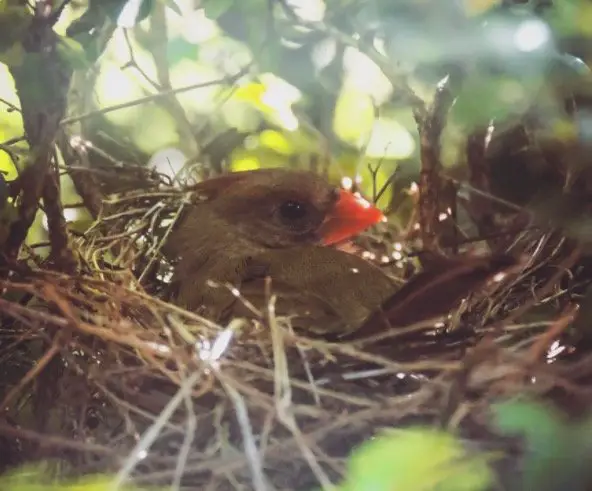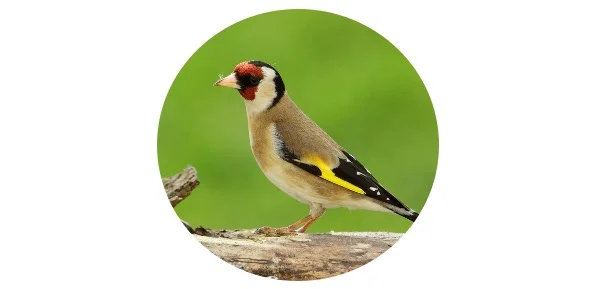Ohio State Bird: Description, Pictures, & Fun Facts

What is Ohio State Bird?
In United States, Ohio is situated in the Midwest area. It is also the seventh highest populous as well as the 34th largest state by land area. The white-tailed Deer is Ohio’s official animal, but what is the Ohio state bird?
In 1933, the Northern Cardinal (Cardinalis cardinalis) was designated Ohio’s official bird. The singing bird of moderate length, famed due to brilliant scarlet red plumage, relocated to Ohio as settlers started clearing the state’s previously dense forests.
Northern Cardinals enjoy a balance of wooded and open regions, thus as the state’s thick woods diminished, the terrain became more appealing to the birds.

Why is Northern Cardinal Ohio State Bird?
Every one must support any animal that wishes to move to your region. Of course, the bird’s stunning deep red colouring did not prevent it from being the state bird, nor does its own significance to humans, because it destroys seedlings and agricultural insects. People kept cardinals as pets, since there were many of them in the state. It’s no wonder that it was named the official bird of Ohio.
When did Northern Cardinal become Ohio State Bird?
Ohio did not have an official bird till 1933., after having waited a long time to designate state emblems since its statehood in 1803. The OGA declared it the official bird in law. The Northern Cardinal is the official bird of Illinois, Indiana, Kentucky, North Carolina, Virginia, and West Virginia.

Natural Habitat of Northern Cardinals
Northern Cardinals are found in dense shrubby areas that include forest edges, fields, hedgerows, backyards, marshy plants, mesquite, regrowing forest, and beautiful landscaping. Cardinals build nests in dense foliage and for singing, they choose conspicuous, fairly high perches. They shifted their habitat towards northward from eastern North America because of the growth of towns and suburbs.
Northern Cardinals Food
Northern Cardinals eat primarily seeds and fruit. They also supplement these with insects mostly to nestling. Many types of seed and fruit like dogwood, wild grape, buckwheat, grasses, sedges, mulberry, hackberry, blackberry, sumac, tulip-tree, and corn are included in their diet.
Cardinals eat many kinds of birdseed, mainly black oil sunflower seeds. They also like to have beetles, crickets, katydids, leafhoppers, cicadas, flies, centipedes, spiders, butterflies, and moths.

Northern Cardinals Nest
One or two weeks before the nesting male and female bird start searching the safe and possible sites. They hold nesting material in their bills, call back and forth while assessing each site. They find a place 1-15 feet high which is hidden in thick foliage.

The nest is fixed into a fork of small branches in a sapling, shrub, or vine tangle. For nesting, they use many kinds of trees and shrubs, like dogwood, honeysuckle, hawthorn, grape, redcedar, spruce, pines, hemlock, rose bushes, blackberry brambles, elms, sugar maples, and box elders.
How Northern Cardinals Build Nest?
The male helps the female in building a nest. He brings the nesting materials and the female crushes the twigs with her beak to make them pliable. Then she bends the twigs around her body to give the shape of a cup. She also uses her feet to push the twigs at bottom of the cup.

The cup consists of four layers: coarse twigs that are covered in a soft leafy mat then there is a lining with grapevine bark The cup has four layers: coarse twigs covered in a leafy mat, then lined with grapevine bark, and finally grasses, stems, rootlets, and pine needles from the last layer.
The nest is 2-3 inches tall.4 inches of the border and an inner diameter of 3 inches. It takes 3 to 9 days to build the nest. Interestingly cardinals don’t use their nests again for laying eggs.
Northern Cardinals Nesting Facts
| Clutch Size | 2-5 eggs |
| Number of Broods | 1-2 broods |
| Egg Length | 0.9-1.1 in (2.2-2.7 cm) |
| Egg Width | 0.7-0.8 in (1.7-2 cm) |
| Incubation Period | 11-13 days |
| Nestling Period | 7-13 days |
| Egg Description | The colour of eggs is grayish-white, greenish-white dappled with pale gray and brown |
| Condition at Hatching | Naked have sparse tufts of grayish down, eyes being closed and, clumsy |

Northern Cardinals Appearance
Northern Cardinal males have brilliant crimson red plumage, while females have reddish-brown feathers. These birds are somewhat bigger than females, but only by a little margin. Aside from it, both of the bird’s sexes are structurally identical.
The bird’s breast and top side of the body are grey, while the stomach is white or light coloured grey. These birds’ beaks are usually black with a brown tint at the bottom.
The Northern Cardinal is eight to nine inches long from head to tail, the length of wingspan between 10 inches to 12 inches. These small birds are barely 1.4 to 1.7 ounces in weight.

Northern Cardinals Behavior
Northern Cardinals hop on low branches and forage near the ground. Cardinals commonly sing from a higher branch of a shrub. The crest which is quite peculiar is raised and pointed when they get agitated.
It looks at a lower position and is hardly visible while resting. During the breeding season, they move around in pairs, but in winter they form fairly large flocks of a dozen to several dozen birds. During foraging, young birds give way to adults and females let the males move ahead of them.
Cardinals can forage with other species also, that are Dark-eyed Juncos, White-throated Sparrows, other sparrow species, Tufted Titmice, goldfinches, and Pyrrhuloxias. They fly somewhat unwillingly on their short, round wings, taking short trips between thickets. Pairs stay together throughout winter but split up by the next season. This is almost 20% of the total pairs.
Northern Cardinals Backyard Tips
If you want to attract cardinals to your yard, you might also consider planting thick greenery that they can use as a protected area in which to nest. A bird feeder of any type can attract Northern Cardinals. However, they prefer sunflower seeds. The undergrowth in the backyard can be left for the nesting of birds.
Northern Cardinals Conservation
According to the North American Breeding Bird Survey, their population increased in 1966 and 2014. Partners in Flight judges a global breeding population of 120 million with 77% living in the U.S., and 22% in Mexico.
They put a 5 out of 20 on the Continental Concern Score and are not on the 2014 State of the Birds Watch List. A large number of houses and their backyards over the last two centuries have been good for cardinals. However, habitat loss in southeastern California causes the disappearance of the cardinal population there.

How do Ohio State Bird behave?
In the wild, birds flourish in vegetation. Their habitat varies somewhat throughout Ohio. They inhabit forests and thickets, as well as brushy areas and fence rows. They like cities and frequent city and state parks, so you shouldn’t have to travel out in the country to see them.
They live for around 13 years to 15 years. Both birds have a mate, and create a nest along with its spouse during this period. Singing is how the both birds interact.
Once they have offspring, the incubation time lasts around 11 days to 13 days. During incubation, the female remains in the nest while the male goes out in search of food, which he returns to the nest.
Cardinals take out for their spouses just like everyone else. When the offspring hatch, the female remains with them to look after them. While the male bird hunts but returns additional food to the nest.
This is done so that the youngsters may eat as well. Whenever you hear “purty-purty-purty” or “cheer-cheer-cheer,” You may hear a parents’ cardinal conversing while isolated as he searches for his brood.
Young birds need special protection and care because they do not hatch with full wings and hence are unable to fly. When a predator enters the nest, the female and all the chicks must defend themselves.
During such a perilous moment, it’s understandable that the pair wants to stay in contact. Humans benefit from their apparently always cheerful demeanour. This also explains why females are seldom seen in your yard.
People instead notice the vividly coloured man out “grocery shopping.” If you see such a cardinal coming to the nest bearing food, it means he as well as his wife have a big brood.

Do Northern Cardinals form communities?
All the cardinals exist in the same pattern as mockingbirds do, by forming a close-knit family and marriage that they zealously guard. To safeguard his house, the cardinal will battle to the death. If it detects a predator, this will fight over its area, which will often involve its family.
Avoid touching the nest of cardinal, and do not permit your kids or pets to do so. You will be attacked by birds. They battle for breeding area as well, another, male cardinals will fight their own species if they enter a nesting place that has previously been established.
They may sometimes attack their own image in a window or mirror. These birds can distinguish members of their own species, as well as animals and people. Despite possessing tiny brains, they are far from “bird-brained,” a term that means unintelligent.
They are, however, unaware that the glass reflects their image. The bird seems to attack the glass, believing it is another cardinal, but it is really battling itself.

What do Northern Cardinals eat in Ohio?
Northern Cardinals have a robust appetite. These birds are omnivores, like many other bird species, However, the ones who established in Ohio developed into herbivores.
As the people of North Carolina enjoy insects, the people of Ohio live on a steady diet of vegetation, fruits, and grains. Because they do not migrate, they may eat just their favourite foods until they are wiped off by a drought.
Sunflower seeds are their favourite food, once you really need to assist them during cold winter season in Ohio, in your garden, place a sunflower seed-filled bird home high above the ground.
The leftover 10 percent of their food is made up of insects found beneath leaves. You can also provide seeds of safflower, peanut pieces, broken corns, and raw berries to the cardinals in your yard.









